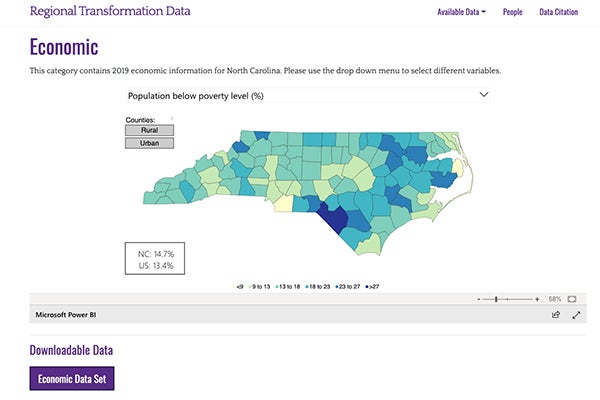ECU develops tool to provide regional transformation data
Following two years of collecting and inputting data, a unique and interactive resource is now available to the public on East Carolina University’s website.
Updated with the latest 2020 U.S. Census information, ECU’s Regional Transformation Data tool provides a snapshot of various ECU, regional and state statistics beneficial for research, grant proposals or general information in one convenient location.

East Carolina University’s Regional Transformation Data website includes data sets related to agriculture, demographics, economics, education, employment, housing and public health. (ECU photo)
Available at the click of a button with easy-to-comprehend graphics, data topics include agriculture, regional demographics, economics, education, employment, housing and public health. Information is continuously updated and the tool continues to evolve.
“Providing access to data that helps researchers explore health, education, demographic, environmental and other questions is in line with ECU’s mission,” said Sharon Paynter, assistant vice chancellor for economic and community engagement. “We wanted to create a tool that would add value to the research community at ECU and even for our partners outside the university.”
The resource was compiled and designed by ECU students, faculty and postdoctoral scholars.
Haleigh Robinson, a senior majoring in community and regional planning, and Francesca Defranco, a senior double majoring in applied sociology and psychology, worked on finding the data sources and aggregating the information.
“I think a lot of times, people feel overwhelmed when looking for data. With this program, we do all the hard work; we pull the information together so it’s a quick and easy way for you to find what you need,” Robinson said.
“It’s a great resource for students working on projects,” Defranco added. “The information is all in one spot. You don’t have to search any other database and can cite one source for it all.”
Janire Pascual-Gonzalez, one of the ECU postdoctoral scholars heading the project, said the team wanted this tool to be relatable, up to date and user friendly.
“We provide for each variable the raw data at a county, state and national level, the year, original source, date of retrieve and GIS visualization,” Pascual-Gonzalez said. She said researchers don’t have to spend time getting used to different interfaces.
Reide Corbett, dean of Integrated Coastal Programs, recently used the data tool for an important grant.
“Place is critical to the work we are doing so understanding the ‘place’ is important,” Corbett said. “… this database allowed us to quickly assess demographics, economic variables and information on housing.”
The Regional Transformation Data site is divided into two parts. The DriveEast data includes various information for all North Carolina counties. Also available on the site are ECU college- and school-specific research or information.
Robinson feels this tool sets ECU apart from other universities. She said, “It lets eastern North Carolina tell its own story. It contributes to the region, and it shows how much we put into the region.”
Users looking for information that isn’t yet included can make submission requests for specific data sets to be added through a button on the website.